Topic 3: Fabrikam, inc.
Case study
This is a case study. Case studies are not timed separately. You can use as much
exam time as you would like to complete each case. However, there may be additional
case studies and sections on this exam. You must manage your time to ensure that you
are able to complete all questions included on this exam in the time provided.
To answer the questions included in a case study, you will need to reference information
that is provided in the case study. Case studies might contain exhibits and other resources
that provide more information about the scenario that is described in the case study. Each
question is independent of the other questions in this case study.
At the end of this case study, a review screen will appear. This screen allows you to review
your answers and to make changes before you move to the next section of the exam. After
you begin a new section, you cannot return to this section.
To start the case study
To display the first question in this case study, click the Next button. Use the buttons in the
left pane to explore the content of the case study before you answer the questions. Clicking
these buttons displays information such as business requirements, existing environment,
and problem statements. If the case study has an All Information tab, note that the
information displayed is identical to the information displayed on the subsequent tabs.
When you are ready to answer a question, click the Question button to return to the
question.
Background
Fabrikam, Inc. manufactures industrial metal cutting machines. The company installs and
services the machines for customers.
Fabrikam has manufacturing plants in Canada, France, and China. The company also has
regional service organizations that are responsible for installation and maintenance of the
machines.
Current environment
Overview
Operations for the company are managed very informally. Only a small number of long term employees are aware of all manufacturing processes. The company has been
experiencing quality issues associated with its manufacturing operations and installations.
The company wants to implement a way to capture quality inspection results for each
machine produced. Current inspection checklists are stored in the Files section of a Teams
channel for inspectors. Inspectors commonly print the incorrect inspection checklist.
The company has specific inspection stations for certain inspection steps. Each station has
the gauges and equipment required for related inspection steps. There is often a backlog at
specific inspection stations. This results in delays in shipping machines to customers.
Accounting system
The current system does not handle shop floor or manufacturing planning
functionality.
Machines are assigned serial numbers and placed in stock until they are shipped
to customers.
Employee information is maintained only within the accounting system. Access to
the information is strictly controlled due to privacy regulations and company
policies.
Other systems
The company has an enterprise Microsoft 365 subscription. The company uses
Microsoft 365 only for sending and receiving email. The company uses photos of
employees to generate employee badges. Photos are uploaded into Microsoft 365
user profiles.
The company recently started using Dynamics 365 Field Service to manage and
maintain the machines that it installs for its customers. The app has not been
customized.
The company has added roles, skills, and certification proficiencies to Dynamics
365 Field Service resources to support both customer onsite inspections and final
manufacturing inspections.
Requirements
Quality inspection app
Fabrikam is evaluating Microsoft Power Platform to determine whether it can meet the
company’s requirements for a manufacturing defect and quality inspection solution. Each
machine produced must be subjected to a quality inspection at various points during
production. Each machine must undergo a more extensive quality inspection before the
machine can be shipped to the customer.
Inspection orders
Inspection orders must:
Inspectors must fill in findings comments and upload at least one photo for any
inspection step that is marked as failed.
Inspection standardization Standardized checklists must be stored in the solution for use by inspectors. A copy must
be created when a new inspection is initiated. The solution must:
Prevent an inspector from proceeding to the next step of the checklist until
required information for a step is entered.
Support the addition of steps to inspections to support custom features added to a
machine for a customer.
Support the direct input of measurements from testing gauges to avoid incorrect
readings being entered by inspectors.
Provide a visual representation of the testing measurement limits for each step.
Include an indication of how the measured value compares to measurement limits
and whether the measurement is within tolerance. Users must be able to configure
the visualizations to display the minimum value and maximum value, and whether
the reading is within the tolerance of a single targeted value. It must also be able
to be used for maintenance inspections once the machine has been installed.
Support the ability to store photo references within each inspection step to
document defects found during inspections.
Security
Users must be active employees of Fabrikam.
When a user signs into the inspection solution, the solution must display a picture
of the employee who has signed in.
Supervisors must be able to modify standard checklists. Other employees must be
prevented from modifying checklists.
You must prevent users from changing inspection order data once an inspection is
marked as final.
Analytics and reporting
The solution must:
Provide metrics including existing and upcoming demand by inspection station,
average time spent per user at a station, and average time a machine spends at
each inspection point.
Provide metrics per inspector including number of inspections performed by
month, and number of inspections per rating type (pass, fail).
Provide a printed quality certificate to be included with each machine.
Issues
During initial testing of the solution, testers report that they cannot see the photos taken
during a previously failed inspection.
You need to recommend components to meet the re-inspection requirements.
Which components should you recommend? To answer, select the appropriate options in
the answer area.
NOTE: Each correct selection is worth one point.

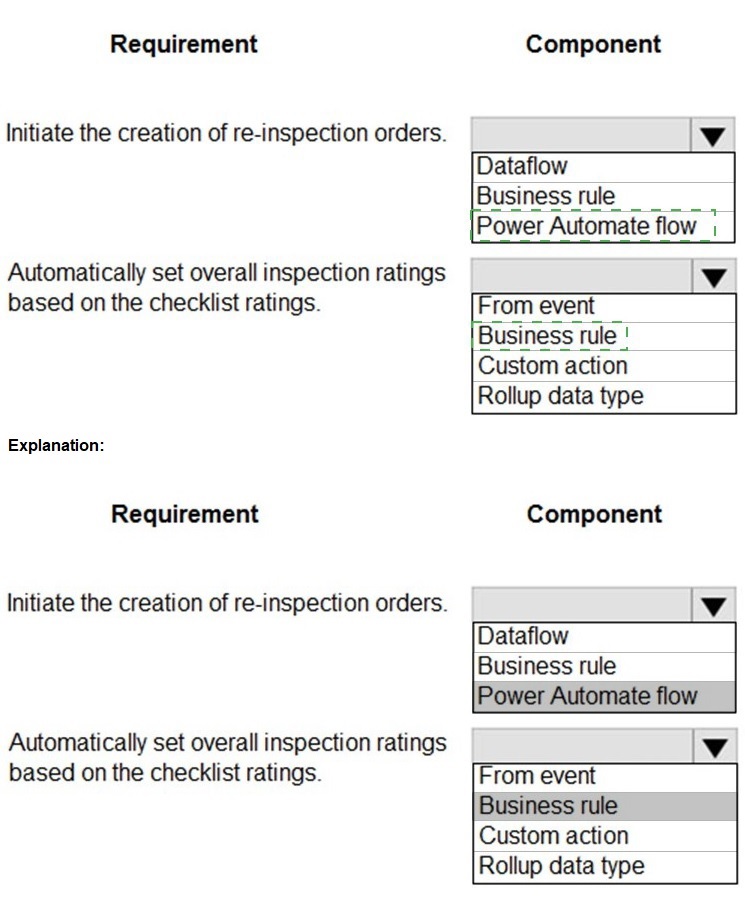
Graphical user interface, text, application
Description automatically generated
Box 1: Power Automate flow
Scenario: Inspection orders must be automatically marked for re-inspection should a
machine fail inspection. The new inspection order must be created by using the originating
inspection order as a template.
Box 2: Business rule
By combining conditions and actions, you can do any of the following with
business rules:
Set column values
Clear column values
Set column requirement levels
Show or hide columns
Enable or disable columns
Validate data and show error messages
Create business recommendations based on business intelligence.
You need to recommend a solution to collect the information required to meet reporting
requirements.
What should you recommend?
A.
Business process flow
B.
Business rule
C.
Business event
D.
Business process modeler
Business rule
Business rule can create business recommendations based on business intelligence.
Scenario: Analytics and reporting
The solution must:
Provide metrics including existing and upcoming demand by inspection station,
average time spent per user at a station, and average time a machine spends at
each inspection point.
Provide metrics per inspector including number of inspections performed by
month, and number of inspections per rating type (pass, fail).
Provide a printed quality certificate to be included with each machine.
Reference:
https://docs.microsoft.com/en-us/learn/modules/define-create-business-rules/
You need to recommend a solution to meet user interface requirements.
What should you recommend? To answer, select the appropriate options in the answer
area.
NOTE: Each correct selection is worth one point.

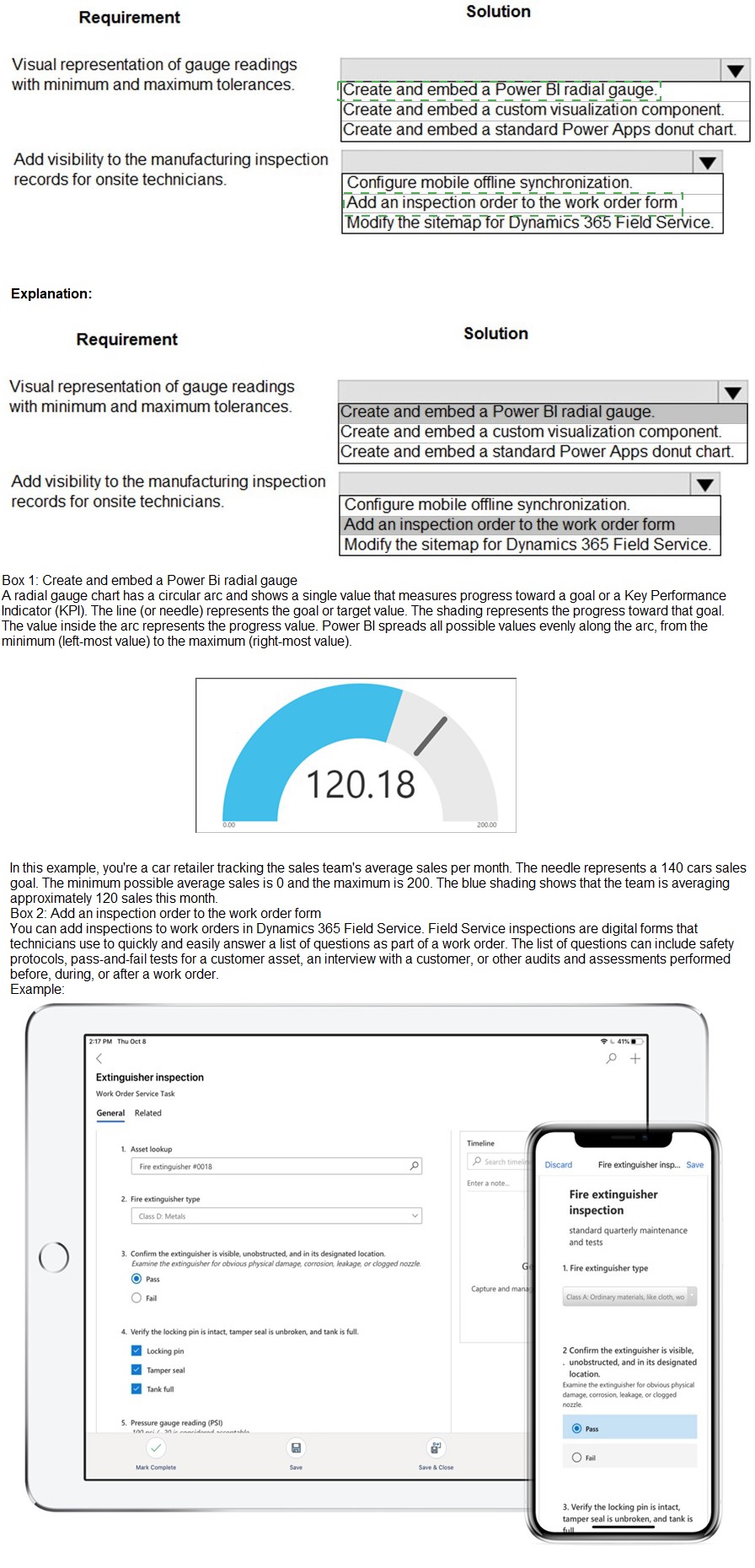
You need to manage user access to the app.
Which two connection types should you recommend? Each correct answer presents part of
the solution.
NOTE: Each correct selection is worth one point.
A.
Virtual table with a customer connector
B.
Office 365 Outlook connector
C.
Microsoft Dataverse connector
D.
Office 365 Users connector
Microsoft Dataverse connector
Office 365 Users connector
Office 365 Users lets you access user profiles in your organization using your Office 365 account. You can use the Use the connection in your Power Platform app.
Dataverse is part of the Microsoft 365 collaboration and productivity tools. Using federation,
applications can connect to Dataverse using the same system user identities and
credentials available in an Azure Active Directory based network.
Scenario:
Users must be active employees of Fabrikam.
Quality inspection app: Fabrikam is evaluating Microsoft Power Platform to
determine whether it can meet the company’s requirements for a manufacturing
defect and quality inspection solution. Each machine produced must be subjected
to a quality inspection at various points during production. Each machine must
undergo a more extensive quality inspection before the machine can be shipped to
the customer.
Reference:
https://docs.microsoft.com/en-us/powerapps/maker/canvas-apps/connections/connectionoffice365-
users
You are evaluating a solution design for a model-driven app that will have a large number
of complex forms.
Many of the forms take up to 10 seconds to load.
You need to recommend solution to speed up loading times for the forms.
Which two solutions should you recommend? Each correct answer presents a complete
solution.
NOTE: Each correct selection is worth one point.
A.
Consolidate and reduce scripts.
B.
Use synchronous JavaScript requests
C.
Move scripts into the OnLoad event.
D.
Remove unnecessary fields
Consolidate and reduce scripts.
Remove unnecessary fields
Controls that require extra data beyond the primary record produce the most strain on form
responsiveness and loading speed. These controls fetch data over the network and often
involve a waiting period (seen as progress indicators) because it can take time to transmit
the data.
Keep only the most frequently used of these controls on the default tab.
Reference:
https://docs.microsoft.com/en-us/powerapps/maker/model-driven-apps/design-performantforms
You are designing a Power Platform solution.
The company wants its development team to adopt the construction of repeatable
components for its
implementation team to reuse on different entities and forms.
You need to recommend a technology that meets these requirements.
Which technology would you recommend the developers adopt to assist the
implementation team?
A.
JavaScript
B.
Power Apps Component Framework control
C.
Web resource
D.
Canvas app
Power Apps Component Framework control
Power Apps component framework empowers professional developers and app makers to
create code components for model-driven and canvas apps (public preview) to provide
enhanced user experience for the users to work with data on forms, views, and
dashboards.
Reference:
https://docs.microsoft.com/en-us/powerapps/developer/component-framework/overview
A local bank uses Microsoft Power Platform apps to store customer data.
The bank IT director discovers that all employees can see the social security numbers of
their customers. The IT team does not understand how field-level security works and needs
help with the design.
You need to recommend a solution to the bank that meets the following requirements:
• The system must restrict access to customer social security numbers to the vice president
of finance only.
• The vice president of finance must be able to read and update customer social security
numbers.
Which two actions should you recommend? Each correct answer presents part of the
solution.
NOT: Each correct selection is worth one point
A.
Set the values for the read permission and for the update permission for social security
number to yet
B.
Enable field-level security for the member table.
C.
Create a held-level security profile
D.
Enable field-level security for the social security number column.
Create a held-level security profile
Enable field-level security for the social security number column.
Field-level security is managed by the security profiles. To implement field-level security, a
system administrator performs the following tasks.
Enable field security on one or more fields for a given entity.
Associate one more existing security profiles, or create one or more new security
profiles to grant the appropriate access to specific users or teams.
Reference:
https://docs.microsoft.com/en-us/power-platform/admin/field-level-security
You are designing a Microsoft Power Platform solution to help a company manage sales
leads.
The solution has the following requirements:
Ensure that users follow a predefined sales process regardless of the device that
employees use to access the app.
Respond to sales events by using organization-defined best practices.
You need to recommend a component for the app.
What should you recommend?
A.
Power Automate cloud flow
B.
Business process flow
C.
Power Automate desktop flow
D.
Playbook
Business process flow
You can help ensure that people enter data consistently and follow the same steps every
time they work with a customer by creating a business process flow. For example, you
might want to create a business process flow to have everyone handle customer service
requests the same way, or to require that people get approval for an invoice before submitting an order. Business process flows use the same underlying technology as other
processes, but the capabilities that they provide are very different from other features that
use processes.
Reference:
https://docs.microsoft.com/en-us/power-automate/business-process-flows-overview
You are performing a requirements analysis for a customer.
The customer provides the following requirements:
Power Platform storage capacity must remain under 100 percent.
Customer service representatives must be sent an email when they are assigned a
case.
Help desk technicians must be shown an error message when they try to delete a
task row.
The plug-in pass rate must remain over 99 percent for the production environment.
You need determine if the requirements are functional or non-functional.
Which requirement type should you use? To answer, drag the appropriate requirement
types to the correct requirements. Each requirement type may be used once, more than
once, or not at all. You may need to drag the split bar between panes or scroll to view content.
NOTE: Each correct selection is worth one point.

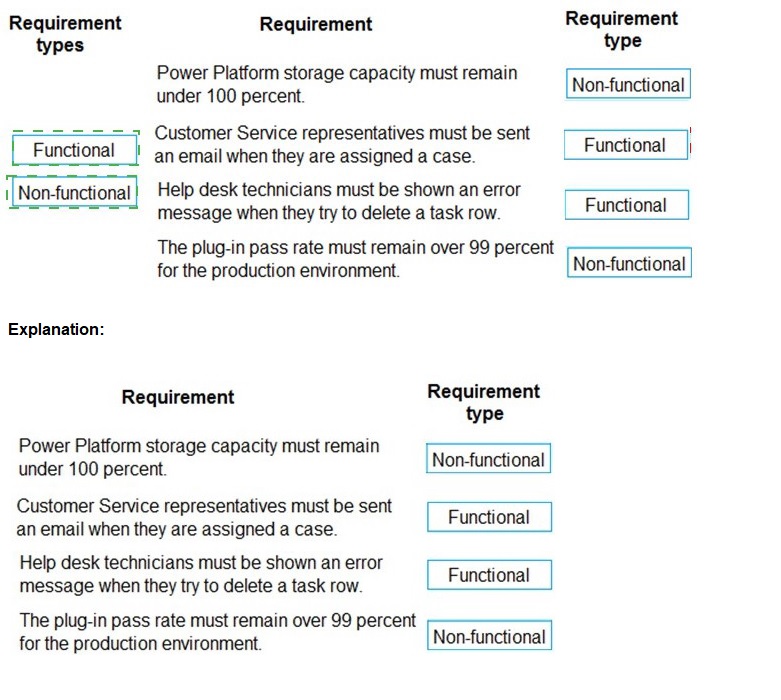
Box 1: Non-functional
Non-functional requirements commonly describe non-behavior aspects of the solution such
as performance requirements.
Box 2: Functional
Functional requirements describe what the solution needs to do or its behaviors.
Box 3: Functional
Box 4: Non-functional
Examples of common non-functional requirement types include:
Availability
Compliance/regulatory
Data retention/residency
Performance (response time, and so on)
Privacy
Recovery time
Security
Scalability
You are designing a Power Platform solution for a company that provides in-home
appliance maintenance. When a customer schedules a service appointment, a dispatcher
assigns one technician for a specific time and location.
The solution must capture information about the technician assigned to each appointment
and the list of tools that the technician must bring to the appointment.
You need to recommend the data type for the captured information.
Which data type should you use? To answer, select the appropriate options in the answer
area.
NOTE: Each correct selection is worth one point.
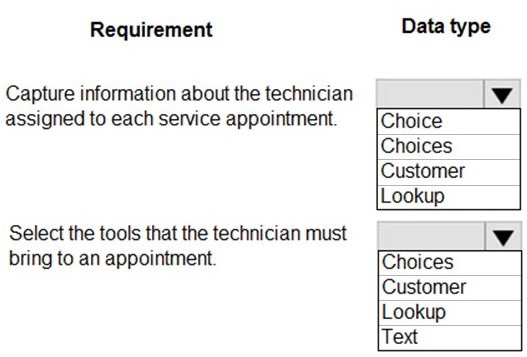
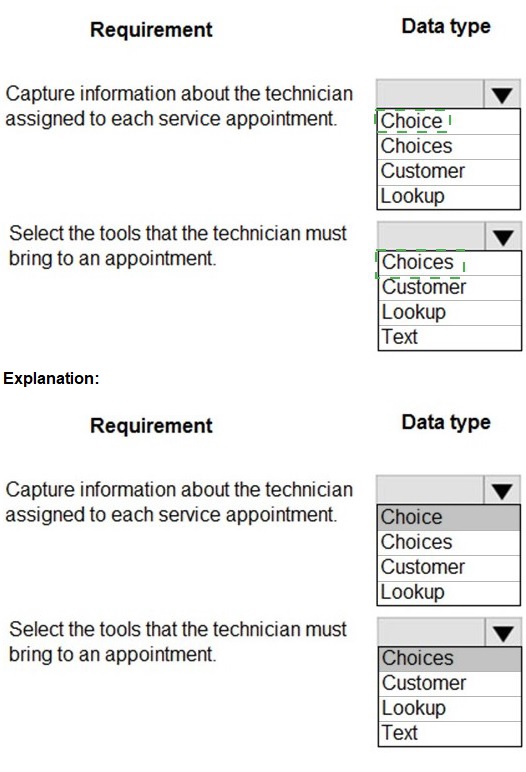
Box 1: Choice
Like Choices below, but can only select one of the option.
Box 2: Choices
You can customize forms (main, quick create, and quick view) and email templates by
adding multi-select columns that are called Choices. When you add a choices column, you
can specify multiple values that will be available for users to select. When users fill out the
form they can select one, multiple, or all the values displayed in a drop-down list.
| Page 4 out of 20 Pages |
| Previous |